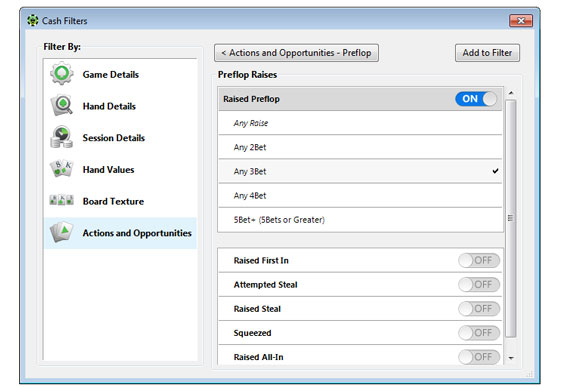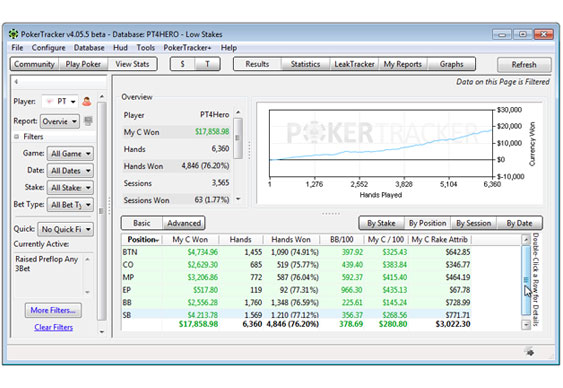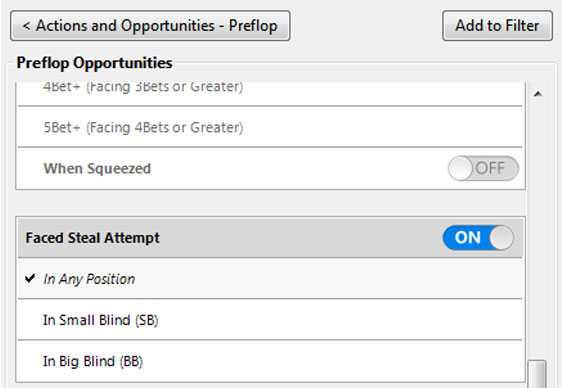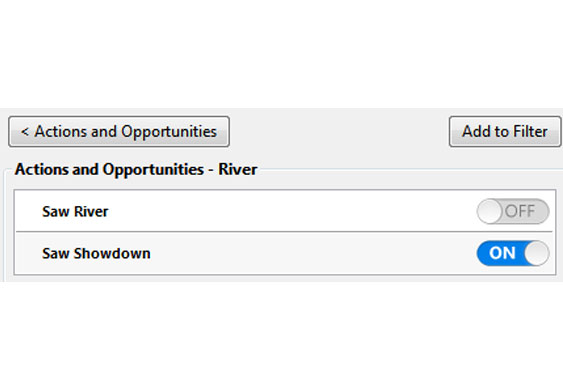PokerTracker 4: Analyzing 3-bet Pots
Monday, 25 November 2013
Mistakes in 3-bet pots can be very costly for NLH players.
Mistakes in 3-bet pots can be very costly for NLH players. A 3-bet pot occurs anytime there is a raise and a re-raise. It’s easy to misplay 3-bet pots in one way or another, and it’s only by analysing these pots away from the table that can we find our own leaks and begin fixing them. Luckily, we can use PokerTracker 4 to filter all of the hands in our database to show only these situations, and use various tools inside PokerTracker 4, such as the replayer or positional reports, to analyse our play. Our goal is to teach you how to create filters to show only 3-bet pot hands, and then how to review the output to make profitable strategic changes. There is no need to hire a costly poker coach just to point out your leaks; with proper post-game review, you can learn how to find leaks in your game on your own.

First, let’s review some of the basic filters we can use to accomplish our goal. To create our filter in PT4, go to the “View Stats” page and then choose “More Filters...” in the left-hand frame. To filter for all hands where “Active Player” (aka you) 3-bet pre-flop, we need to choose the “Actions and Opportunities” subgroup. This is where we can find filters to show only any actions or reactions that the Active Player may have taken during the course of a hand, as well as the opportunities the Active Player had to take an action, or when facing an opponent’s specific activity. From here, we will drill down to select the necessary filter by choosing “Actions and Opportunities – Preflop” and then “Preflop Raises”. Click “Any 3Bet”. A tick will appear next to this filter and the on-switch will show under “Raised Preflop”. Click “Add to Filter” and then “Save & Apply Filters” to see the result of every single pre-flop 3-bet you’ve made in the report below.

Take a look at your winnings results column. A good player’s winnings in this column should be quite profitable over a long period of time, and not just because it includes the times that you 3-bet premium hands like K-K and A-A. If your results are negative, you should consider putting some serious work into your 3-bet strategy away from the table.
Let’s go a step further and analyse just the results of 3-betting A-K/Q-Q/J-J. These are all premium hands as well, but they are not part of the “nut range” of possible hands. To do this, go back to “More Filters...” and click “Add Filter” to continue where we left off. Select “Hand Values” > “Hole Cards Range Selection” > “Holdem Hand Range” and choose A-K, Q-Q, J-J. Click “Add to Filter” and then “Save & Apply Filters” to review the results of this change.
Once again, your results should be positive if you are a winning player over a large sample size. In this situation, if I look at my own 100NL database by position, you see that I am losing slightly from the small blind in 3-bet pots. I chose to view my results in US dollars because the games I play in use this currency, but you can easily switch to BPS or EUR and have the application convert the currency in the background.
The report shows that I am losing less than a buy-in from both the big blind and small blind. I am performing well but I still want to drill-down and see if there are any leaks. To do this, we double-click the small blind column to add an additional filter that will restrict the position to the small blind. Are there any bad pre-flop all-ins? Are we bluff continuation-betting too often when we 3-bet with A-K, get called, and the flop comes low? How is our play with Q-Q when villain calls the 3-bet and we see an A-x-x or K-x-x flop? These filters show us basic results but are really useful in that they find us the exact hands that we need for analysing and re-checking our decisions in the hand.

Another excellent filter will show how we are performing when 3-betting a steal attempt pre-flop, aka re-stealing. To do this, we will remove Q-Q, J-J, A-K from the existing filter, then click “Add Filter” > “Actions and Opportunities” > “Actions and Opportunities – Preflop” > “Preflop Opportunities” > “Faced Steal Attempt”. Don’t forget to add to add and save the filter to see your results.
This should also be positive, once again because the range is heavy with A-A/K-K and other premium hands. To see how you perform when re-stealing with junky or “air” hands, go back and include a hand-range filter that only includes the worst of your possible 3-bet range. If you have a positive win-rate when re-stealing with junk hands, check the hands in the report to make sure they were all theoretically good re-steal spots and consider looking for more re-steal spots in your game. If not, then check the hands in the report to try to determine why. Are you re-stealing against the wrong player types? Are you leaking post-flop after the pre-flop re-steal attempt gets called? What is creating the loss and should you adjust your re-stealing strategy? These are all good questions to ask yourself as you review your play.

The last filter I want to show you is how to review 3-bet pots that go to showdown. To do this, we want to erase all filters except for “Raised Preflop Any 3Bet” and then go to “Actions and Opportunities” > “Actions and Opportunities – River” to turn “Saw Showdown” on.
Yet again, this should be a positive filter, but it does include A-A/K-K. For smaller databases (fewer than 50K hands), you probably won’t find a tremendous amount of hands here, and in that case I would suggest reviewing pretty much all of the possible hands, but if you have a large enough database you may want to remove these premium hands in the filter to review only non-premium starting hands. Look at the lines you choose and really consider the validity of the original 3-bet, your continuation-bets, and any future bets/calls made in the hand. See if you left value on the table by checking against the wrong opponents, or if you took a single pair too far against a nit.
Tools like PokerTracker 4 are great for running filters and analysing your play, but ultimately you will need to review your hands and results to get the most from this software. Use these filters as a starting point and then modify them as you need to. For instance, review hands where you squeezed air, hands where you re-stole and then didn’t see showdown, hands where you 3-bet and saw an over-card on the flop, etc. These filters should help you find hands that influence your win-rate and highlight leak areas in your game. So, get to work, run some filters, and start improving your 3-bet game!
Good luck and happy grinding!
James Sweeney is a noted poker coach, and author of the book Dynamic Full Ring Poker: Beyond the Basics, published by Daily Variance. James contributed to the tutorial content development and support of PokerTracker 4, and remains an active player advisor to the PokerTracker management team. His single-serve coaching video content is available at splitsuit.com, featuring his newest release The 100K Micro-Stakes System: Crushing 50NL in 2012.